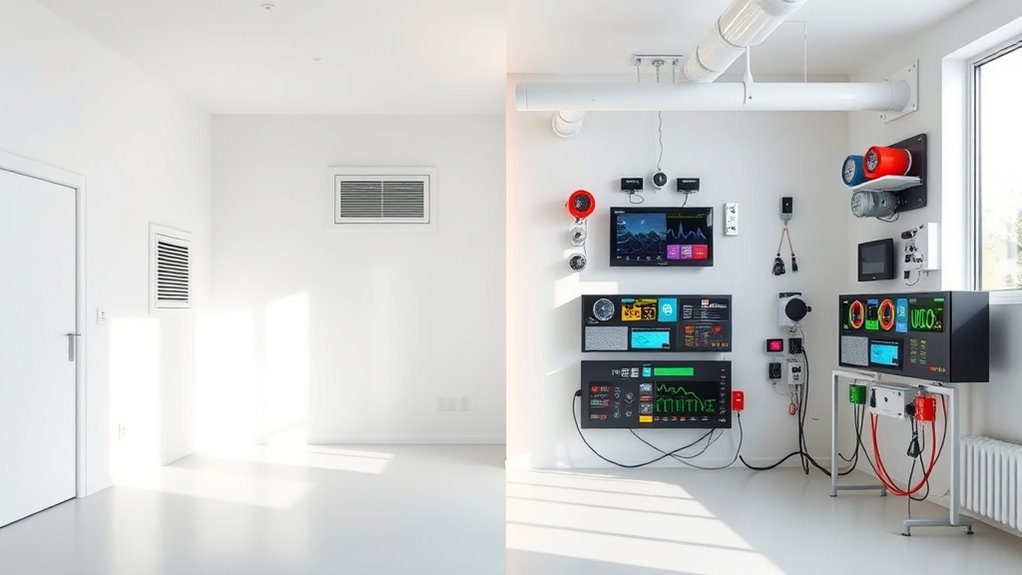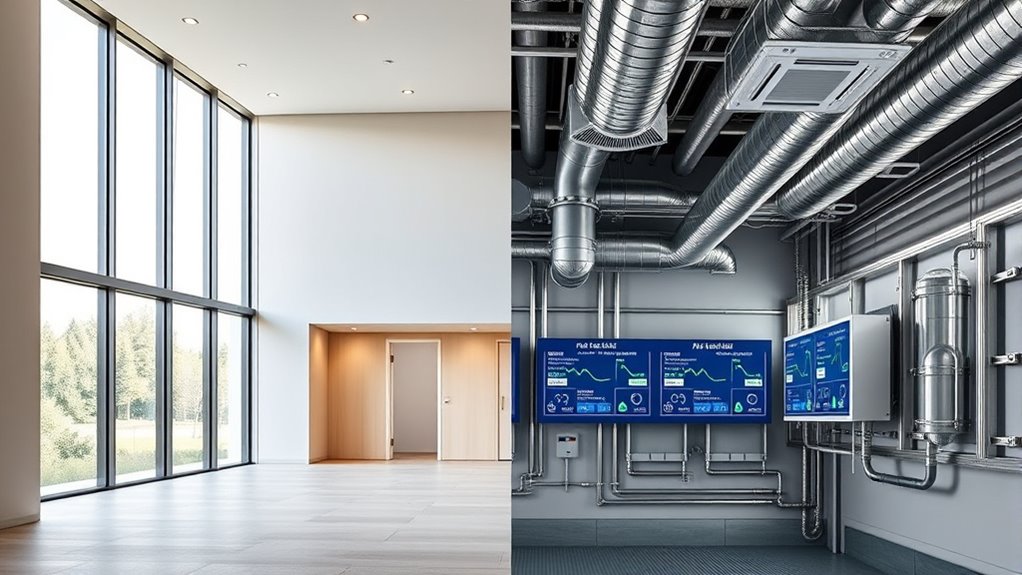Certified Passive House standards focus on building design and efficient ventilation to naturally maintain indoor air quality, without relying on extra filtration devices. They create airtight spaces that limit outdoor pollutant infiltration and use heat recovery systems to ensure fresh air stays clean. In contrast, active air quality standards involve additional filtration and air cleaning equipment. To discover how these approaches compare and find out which might suit your needs, keep exploring the details below.
Key Takeaways
- Certified Passive Houses prioritize airtightness and efficient ventilation to maintain indoor air quality without additional air cleaning devices.
- Active air quality standards often involve supplementary filtration systems or air purifiers for pollutant removal.
- Passive House standards focus on building design and ventilation efficiency rather than relying on active filtration methods.
- Active air quality standards typically include measurable pollutant reduction targets, unlike Passive House certification.
- Both approaches aim to improve indoor air quality but differ in methodology: Passive Houses use passive design, active standards may include active filtration.

Passive House air quality standards set a high bar for indoor environments by prioritizing clean, fresh air and minimizing pollutants. These standards focus on creating spaces where you feel comfortable and healthy, mainly through optimizing ventilation efficiency and controlling indoor pollutants. You’re probably aware that poor air quality can lead to health issues, discomfort, and decreased productivity. That’s why Passive House designs emphasize airtight construction combined with highly efficient ventilation systems to ensure a continuous supply of fresh air without wasting energy.
In a Passive House, ventilation isn’t just about exchanging air; it’s about doing so efficiently. The ventilation systems are carefully engineered to recover heat from outgoing air, reducing energy loss while maintaining excellent indoor air quality. This means you get a steady flow of filtered, fresh air that keeps indoor pollutants at bay, improving your overall health and comfort. The air exchange rate is meticulously calibrated so that indoor pollutants—like dust, allergens, and volatile organic compounds—don’t accumulate. As a result, you’re less exposed to airborne irritants, which is especially important if you’re sensitive or suffer from respiratory issues.
The Passive House approach inherently limits the infiltration of outdoor pollutants through rigorous airtightness. This prevents unwanted contaminants, such as vehicle emissions or pollen, from entering your living space. By controlling the indoor environment tightly, you gain a significant advantage over traditional buildings that often struggle with drafts and uncontrolled air leakage. The system’s high ventilation efficiency means you don’t need to open windows constantly, which could let in more pollutants or temperature fluctuations, especially in urban environments. Instead, you get a consistent, controlled flow of clean air that enhances indoor air quality without compromising energy efficiency.
When comparing Passive House standards to active air quality management methods, the key difference lies in the passive’s reliance on building design and ventilation efficiency rather than additional filtration or air cleaning devices. Passive House standards aim for a naturally healthy environment through meticulous construction and ventilation, making it a sustainable choice for long-term indoor air quality. You’ll notice that your indoor air feels fresher, and you might even see a reduction in allergy symptoms or respiratory discomfort. Overall, Passive House standards set a robust foundation for indoor air quality by effectively balancing ventilation efficiency and pollutant control, creating healthier, more comfortable indoor spaces that prioritize your well-being.
Frequently Asked Questions
How Do Costs Compare Between Passive House and Active Air Quality Systems?
You’ll find that the cost comparison between passive houses and active air quality systems varies. Passive houses typically have higher upfront costs due to advanced insulation and construction standards, but save money over time through lower energy bills. Active air quality systems might be less expensive initially but can add ongoing operational costs. When planning your project, consider your budget considerations carefully to choose the option that balances costs and long-term benefits.
Can Existing Buildings Be Upgraded to Meet Passive House Standards?
Yes, you can upgrade existing buildings to meet passive house standards, but retrofit challenges exist. You’ll need to improve the building envelope markedly to enhance insulation and airtightness. Addressing these challenges involves careful planning, potentially costly modifications, and ensuring minimal disruption. Properly upgrading the building envelope is key to achieving the energy efficiency and comfort that passive house standards demand, making the retrofit a worthwhile investment.
What Maintenance Is Required for Passive House Air Quality Systems?
Think of your passive house’s air quality system as a garden that needs regular tending. You should replace air filters regularly to keep the air fresh and clean. Also, perform routine ventilation system upkeep—clean vents, check fans, and inspect ducts—to prevent dust and mold buildup. These simple tasks guarantee your indoor air remains pure and healthy, just like a well-maintained garden flourishes with care.
How Do Passive House Standards Address Outdoor Air Pollution?
You guarantee good indoor air quality by using advanced indoor filtration systems that remove outdoor pollutants effectively. Passive house standards address outdoor air pollution by maintaining high ventilation efficiency, which means fresh air is constantly brought in while pollutants are filtered out. This balance keeps your indoor environment healthy and comfortable, even in areas with high outdoor pollution levels. Proper filtration and efficient ventilation are key to managing outdoor air quality impacts.
Are There Regional Differences in Implementing These Air Quality Standards?
Think of implementing air quality standards like steering a river with different currents; regional policies and cultural influences shape how smoothly you flow. You’ll find that some regions prioritize stricter regulations, while others adapt standards to local customs and building practices. These differences influence how effectively air quality measures are adopted, making regional context essential. You, thus, need to take into account local policies and cultural nuances to guarantee standards are both practical and effective.
Conclusion
In the battle between certified passive house standards and active air quality measures, you hold the power to transform your indoor environment. Passive houses might be incredibly efficient, but embracing active air quality standards can create an oasis so pure, it’s like breathing in fresh mountain air every day. Don’t settle for less than the best—your health and comfort deserve nothing short of a home that’s truly a sanctuary. Make the switch and breathe easier today!










